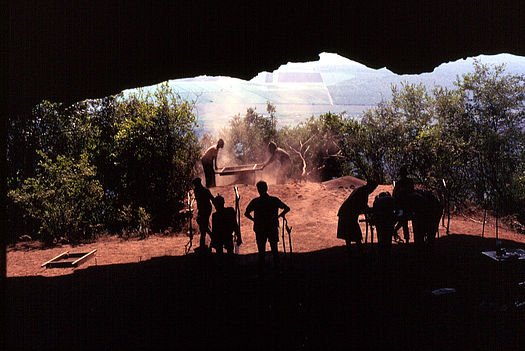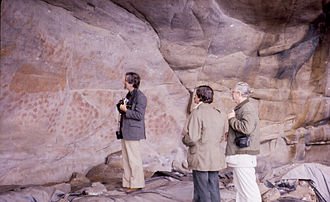The Later Stone Age of South Africa : Early Later Stone Age, Robberg and Robberg-like microlithic assemblages

Dear Reader
In this following series of posts we are covering the Later Stone Age of South Africa, I highly encourage you to please read the Introduction, Historical Background, Advances in Later Stone Age, Climatic conditions of the LSA in South Africa, Elements characteristic of the Later Stone Age and The Later Stone Age sequence posts to this series to bring you update to date with the information and terminology we have covered so far.
Early Later Stone Age, Robberg and Robberg-like microlithic assemblages
(ca 22 000 BP to 12 000 BP)
Dating (more than 22 000 BP to 12 000 BP)
Transitional assemblages found between Middle Stone Age (MSA) and Later Stone Age (LSA) technologies are rare, and some of these have not yet been reliably dated. Where early LSA assemblages occur in a developing sequence between MSA and developed LSA horizons such as at Border Cave, the transition appears to be between 40 000 and 30 000 BP. However, the earliest dates for the early LSA assemblages of more than 25 000 BP originate from sites for which, at present, we have neither additional supporting dates nor palaeoclimatic data, or these early dates are attributed to sites where the stratigraphy is problematic (Mitchell 1988:253-257).
The timing of this transition to fully developed LSA technologies varies considerably, but the latest deposits with definite affinities to early LSA date to 12 000 BP. In most of these later assemblages bladelet production is intensified, with a higher percentage of bladelets being present than in more informal assemblages (ie those preceding 25 000 BP).
The character of the early LSA assemblages
Our samples of these industries is still small and the dates are inconsistent, making a synthesis of this period difficult. The transition from MSA to LSA technologies can be dated to between 30 000 and 20 000 BP. Arguments for an even earlier date, between 40 000 and 60 000 BP, have still to be substantiated.
Extensive excavations of various sites, in particular those with a long sequence of occupation deposits in the Cape, the Free State and Gauteng, has led to the recognition of the existence of an early LSA phase at some sites (predating the Oakhurst and Wilton). This stage is represented in the southern and eastern Cape by the Robberg Industry (named after the Robberg Peninsula on which Nelson Bay Cave is located and where the Robberg was first recognised). This earlier phase of the LSA was also present at sites such as Melkhout boom, Byneskranskop in the south-western Cape, Elands Bay Cave on the west Cape coast, and possibly a few other sitess (Umhlatuzana and Shongweni in Kwa-Zulu Natal; Equus Cave in the northern Cape; Heuningneskrans and Bushmans Rock Shelter in Mpumalanga).
Early LSA assemblages are also present in Lesotho and Swaziland. In the Free State this earlier industry is recognised at Rose Cottage Cave. The Rose Cottage Material and the material from Sehonghong in Lesotho are comtemporaneous and very similar to the Robberg Industry; however, they have not been formally included in the Robberg industry and are often referred to as Early LSA (ELSA) (Wadley 1993:265). Early microlithic assemblages are also present at Cave James Shelter in Gauteng (Wadley 1993). If the single date of 29 000 BP obtained from charcoal in a stone-lined hearth is corroborated, this assemblage in the Magaliesburg area represents one of the earliest expressions of the LSA.
- This early expression of the LSA definitely reflects the character of the LSA:items found at these sites include ostrich eggshells items and other material culture associated with San hunter-gatherer ethnography (Mitchell 1988:6). Typical LSA artefacts that appear in small numbers include ostrich eggshell beads and water containers, polished bone points and link-shafts, tortoise shell bowls, as well as a few small bored stones or other groundstone work.
- Typical MSA characteristics (such as faceted platforms and radially prepared cores) are uncommon in the early LSA assemblages. Points with secondary flaking are absent or rare.
- The early LSA also has a very low percentage of formally retouched tools.
- Bladelet cores and unretouched bladelets smaller than 25 mm are generally present. Concentrations of bladelets sometimes occur in the Robberg Industry levels at Boomplaas, suggesting that they may have been kept in some kind of container or bag. The function of these bladelets is not yet known. They could have been used as inserts in spears (for in the hunting of large game) or as inserts in other composite implements.
- Scrapers are small(<25mm).
- Fine-grained materials such as quartz , quartz crystals and other crypto-crystalline material are preferred.
- At sites such as Elands Bay Cave in the Western Cape and Umhlatuzana in Kwa-Zulu Natal, the presence of large, naturally backed knives on hornfels before 12 000 BP indicates elements of the nonmicrolithic Oakhurst.
Images are link to their sources in their description and references are stated within the text.
Thank you for reading
Thank you @foundation for this amazing SteemSTEM gif




So excited to know more about this.
Definitely worth an upvote and a resteem :]
Good article. Make discoveries about Nigeria
Thanks for your content about African centers and assemblages (especially for detailed technological descriptions) at Paleolithic. African Paleolithic period is an important geograhphy for understanding the dynamics and processes (not only for archaeology but also anthropology) of this period and it is very nice see a kind of this content in steemit, thanks again.
Hi @seewithme, Thank you for an excellent comment. Do you have a Steemit chat account?
Hi @zest, yes i created a chat account as @seewithme with same name. i am a newcomer :)
Send me direct message :)
The markers on the Rose Cottage photo are quite helpful. Thank you
The Stone Age is the period generally in the vicinity of 2,500,000 and 3,000 years previously Christ., And its principle highlight is the human learning methods for the improvement of chasing devices and stone devices. The Stone Age is isolated into the accompanying stages: Paleolithic or Old Age, or Mesolithic and Neolithic Ages or New Age.
The Paleolithic is separated, thusly, in Lower, Middle and Upper. The Lower goes in the vicinity of 2,500,000 and 100,000 years BC., And is described by nomadism vagrant man looking for sustenance and water to guarantee their survival. The main settlements were set up in caverns, sanctuaries and waterway patios. Human action depended on the social occasion, angling and chasing in a savage economy. The primates developed from homo habilis' to 'homo erectus', which accomplishes the last erguimiento individual.
The Middle Paleolithic sequence has in the vicinity of 100,000 and 35,000 BC. At this stage, primates developed to homo neanderthalensis', with more noteworthy stature and cranial limit. The Neanderthal Mousterian culture created, which permitted the advancement of stone apparatuses, including improvement of bifaces, tomahawks, scrubbers, and lances.
The Upper Paleolithic covers in the vicinity of 35,000 and 10,000 BC. Develops adaptation 'homo sapiens, higher cranial limit and simplicity of adapting new learning (intelligence). Man 'sapiens' stone instruments to enhance the improvement of lances, lances and cuts, and builds up the stone craftsmanship with chasing scenes and representative.
The Mesolithic or Middle Stone Age traverses in the vicinity of 10,000 and 5,000 BC. The finish of glaciation supported the Earth's an Earth-wide temperature boost, movement or vanishing of some expansive warm blooded animals and the adjustment of stone devices to the new nature (medium or little creature), with the generation of microliths. Likewise, the stone craftsmanship was reached out in the Iberian Peninsula from the Cantabrian drift toward the east, where an expansion of outdoors exhibitions.
The Neolithic or New Stone Age is the time of ancient times from about the 5,000 and 3,000 BC. The Neolithic Revolution prompted a stationary way of life in light of the person with the rise of the principal towns and learning of agribusiness, domesticated animals, stoneware and exchange improvement. Along these lines, the Neolithic man developed from a ruthless economy to a profitable economy and exchange. This phase of ancient times is the climax of the Stone Age.
Stone Age Prehistory Metal Age Mesolithic Neolithic Paleolithic Man Australopithecus Groups primitive migrant Neolithic unrest history
Souer bro
thank you I have learnt a lot.
merci a vous pour ce sujet de @bakabou159704
Great post friend .. I like this your post.. @zest